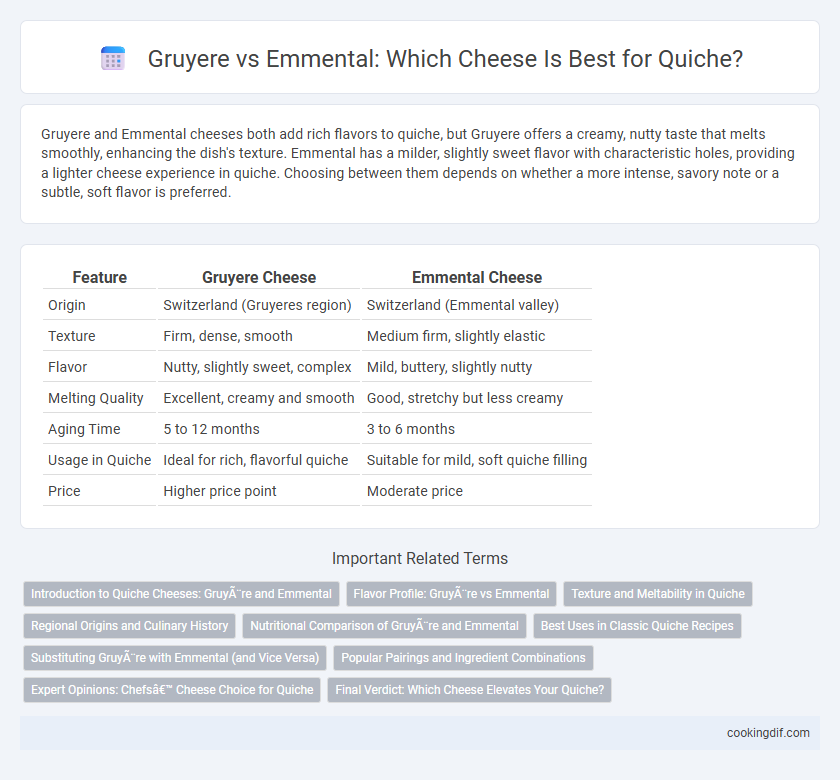Gruyere and Emmental cheeses both add rich flavors to quiche, but Gruyere offers a creamy, nutty taste that melts smoothly, enhancing the dish's texture. Emmental has a milder, slightly sweet flavor with characteristic holes, providing a lighter cheese experience in quiche. Choosing between them depends on whether a more intense, savory note or a subtle, soft flavor is preferred.
Table of Comparison
| Feature | Gruyere Cheese | Emmental Cheese |
|---|---|---|
| Origin | Switzerland (Gruyeres region) | Switzerland (Emmental valley) |
| Texture | Firm, dense, smooth | Medium firm, slightly elastic |
| Flavor | Nutty, slightly sweet, complex | Mild, buttery, slightly nutty |
| Melting Quality | Excellent, creamy and smooth | Good, stretchy but less creamy |
| Aging Time | 5 to 12 months | 3 to 6 months |
| Usage in Quiche | Ideal for rich, flavorful quiche | Suitable for mild, soft quiche filling |
| Price | Higher price point | Moderate price |
Introduction to Quiche Cheeses: Gruyère and Emmental
Gruyere and Emmental are two classic cheeses commonly used in quiche for their distinct flavors and melting properties. Gruyere offers a nutty, slightly sweet taste with a dense texture that enhances the richness of the custard, while Emmental provides a milder, buttery flavor and creates a creamy, smooth consistency. Selecting between Gruyere and Emmental influences the quiche's overall taste profile and texture, making them essential choices in traditional quiche recipes.
Flavor Profile: Gruyère vs Emmental
Gruyere offers a rich, nutty flavor with a slightly sweet and earthy undertone, making it ideal for adding depth to quiche. Emmental delivers a milder, buttery taste with subtle fruity notes, creating a lighter cheese experience. Choosing Gruyere enhances the quiche with a robust complexity, while Emmental provides a smooth, gentle flavor profile.
Texture and Meltability in Quiche
Gruyere offers a creamy, smooth melt with a slightly firm texture that enhances the quiche's custard, providing a rich, buttery mouthfeel. Emmental melts more evenly, producing a gooey and elastic consistency that creates a lighter, springier texture in the quiche. Choosing Gruyere results in a denser, more indulgent filling, while Emmental contributes to a balanced melt with a mild, nutty flavor perfect for a softer quiche crust.
Regional Origins and Culinary History
Gruyere cheese originates from the Gruyere region in Switzerland and boasts a rich, slightly nutty flavor, making it a traditional choice for authentic quiche recipes. Emmental, also Swiss, comes from the Emmental Valley and is characterized by its mild, buttery taste and distinctive holes, often preferred for a lighter texture in baking. Both cheeses have deep culinary histories linked to Swiss cheesemaking but offer distinct regional flavors that influence the character of quiche dishes.
Nutritional Comparison of Gruyère and Emmental
Gruyere contains approximately 413 calories and 33 grams of protein per 100 grams, with higher levels of calcium and phosphorus, supporting bone health and muscle function. Emmental offers around 380 calories and 28 grams of protein per 100 grams, with slightly less fat and sodium, making it a lighter option for those monitoring cardiovascular health. Both cheeses provide essential vitamins such as vitamin A and B12, but Gruyere's richer nutritional profile benefits quiche recipes that require a robust, creamy texture.
Best Uses in Classic Quiche Recipes
Gruyere and Emmental are both popular Swiss cheeses used in classic quiche recipes, but Gruyere's rich, nutty flavor and excellent melting properties make it ideal for achieving a creamy, smooth texture in quiches like Quiche Lorraine. Emmental offers a milder taste and a firmer texture that provides a subtle sweetness and slight elasticity, which works well in vegetable or lighter quiche varieties where a less intense cheese flavor is preferred. For traditional quiches requiring depth and complexity, Gruyere is often favored, while Emmental suits recipes aiming for a delicate balance and gentle cheese presence.
Substituting Gruyère with Emmental (and Vice Versa)
Gruyere and Emmental are both Swiss cheeses but differ in texture and flavor, impacting quiche taste and consistency when substituted. Gruyere offers a rich, nutty flavor and melts smoothly, ideal for a creamy quiche filling, while Emmental provides a milder, slightly sweet taste with a more elastic texture. When substituting Gruyere with Emmental, enhance flavor by adding a sharper cheese or seasoning; substituting Emmental with Gruyere results in a richer, more complex flavor profile that suits traditional quiche recipes.
Popular Pairings and Ingredient Combinations
Gruyere offers a rich, nutty flavor that enhances quiche fillings with caramelized onions, bacon, or mushrooms, creating a creamy and savory texture. Emmental provides a milder, slightly sweet taste that pairs well with spinach, ham, or leeks, adding a smooth melt and subtle depth to the dish. Both cheeses complement eggs and cream perfectly, but Gruyere is favored for intense flavor profiles, while Emmental suits lighter, fresher combinations.
Expert Opinions: Chefs’ Cheese Choice for Quiche
Chefs often prefer Gruyere for quiche due to its rich, nutty flavor and smooth melting quality that enhances the custard texture. Emmental is favored for its milder taste and slightly firmer texture, providing a subtle cheesiness without overpowering other ingredients. Expert opinions highlight Gruyere as the quintessential choice for a classic quiche Lorraine, while Emmental suits lighter, vegetable-focused quiches.
Final Verdict: Which Cheese Elevates Your Quiche?
Gruyere's rich, nutty flavor and excellent melting qualities create a creamy and savory quiche filling, making it the preferred choice for traditional French quiches. Emmental offers a milder, slightly sweet taste with a smooth melt, ideal for lighter quiche varieties or when subtlety is desired. For a classic, robustly flavored quiche, Gruyere elevates the dish with depth and complexity, while Emmental suits recipes emphasizing gentle creaminess.
Gruyère vs Emmental for cheese Infographic

 cookingdif.com
cookingdif.com